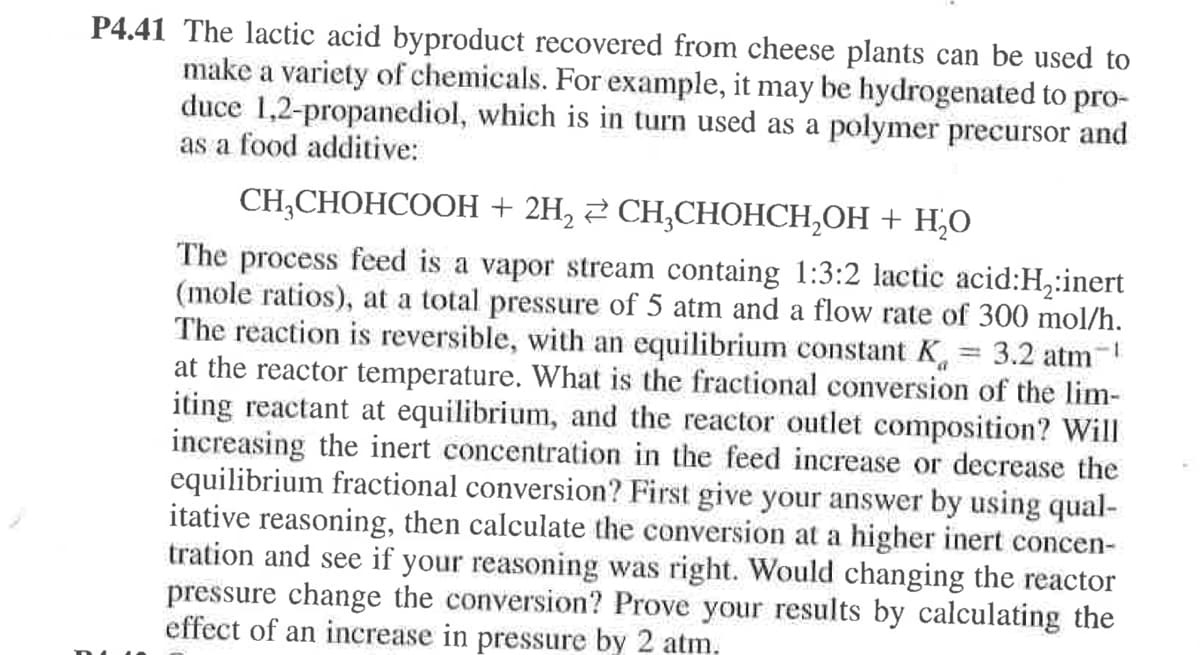P4.41 The lactic acid byproduct recovered from cheese plants can be used to make a variety of chemicals. For example, it may be hydrogenated to pro- duce 1,2-propanediol, which is in turn used as a polymer precursor and as a food additive: CH,CHOHCOOH + 2H, 2 CH,CHOHCH,OH + H,O The process feed is a vapor stream containg 1:3:2 lactic acid:H,:inert (mole ratios), at a total pressure of 5 atm and a flow rate of 300 mol/h. The reaction is reversible, with an equilibrium constant K, = 3.2 atm at the reactor temperature. What is the fractional conversion of the lim- iting reactant at equilibrium, and the reactor outlet composition? Will increasing the inert concentration in the feed increase or decrease the equilibrium fractional conversion? First give your answer by using qual- itative reasoning, then calculate the conversion at a higher inert concen- tration and see if your reasoning was right. Would changing the reactor pressure change the conversion? Prove your results by calculating the effect of an increase in pressure by 2 atm,
P4.41 The lactic acid byproduct recovered from cheese plants can be used to make a variety of chemicals. For example, it may be hydrogenated to pro- duce 1,2-propanediol, which is in turn used as a polymer precursor and as a food additive: CH,CHOHCOOH + 2H, 2 CH,CHOHCH,OH + H,O The process feed is a vapor stream containg 1:3:2 lactic acid:H,:inert (mole ratios), at a total pressure of 5 atm and a flow rate of 300 mol/h. The reaction is reversible, with an equilibrium constant K, = 3.2 atm at the reactor temperature. What is the fractional conversion of the lim- iting reactant at equilibrium, and the reactor outlet composition? Will increasing the inert concentration in the feed increase or decrease the equilibrium fractional conversion? First give your answer by using qual- itative reasoning, then calculate the conversion at a higher inert concen- tration and see if your reasoning was right. Would changing the reactor pressure change the conversion? Prove your results by calculating the effect of an increase in pressure by 2 atm,
General Chemistry - Standalone book (MindTap Course List)
11th Edition
ISBN:9781305580343
Author:Steven D. Gammon, Ebbing, Darrell Ebbing, Steven D., Darrell; Gammon, Darrell Ebbing; Steven D. Gammon, Darrell D.; Gammon, Ebbing; Steven D. Gammon; Darrell
Publisher:Steven D. Gammon, Ebbing, Darrell Ebbing, Steven D., Darrell; Gammon, Darrell Ebbing; Steven D. Gammon, Darrell D.; Gammon, Ebbing; Steven D. Gammon; Darrell
Chapter3: Calculations With Chemical Formulas And Equaitons
Section: Chapter Questions
Problem 3.141QP: A power plant is driven by the combustion of a complex fossil fuel having the formula C11H7S. Assume...
Related questions
Question

Transcribed Image Text:P4.41 The lactic acid byproduct recovered from cheese plants can be used to
make a variety of chemicals. For example, it may be hydrogenated to pro-
duce 1,2-propanediol, which is in turn used as a polymer precursor and
as a food additive:
CH-CНОНСООН + 2H, 2 СH,СНОНСН,ОН + Н.О
The process feed is a vapor stream containg 1:3:2 lactic acid:H,:inert
(mole ratios), at a total pressure of 5 atm and a flow rate of 300 mol/h.
The reaction is reversible, with an equilibrium constant K, 3.2 atm-
at the reactor temperature. What is the fractional conversion of the lim-
iting reactant at equilibrium, and the reactor outlet composition? Will
increasing the inert concentration in the feed increase or decrease the
equilibrium fractional conversion? First give your answer by using qual-
itative reasoning, then calculate the conversion at a higher inert concen-
tration and see if your reasoning was right. Would changing the reactor
pressure change the conversion? Prove your results by calculating the
effect of an increase in pressure by 2 atm.
Expert Solution
This question has been solved!
Explore an expertly crafted, step-by-step solution for a thorough understanding of key concepts.
This is a popular solution!
Trending now
This is a popular solution!
Step by step
Solved in 2 steps with 5 images

Knowledge Booster
Learn more about
Need a deep-dive on the concept behind this application? Look no further. Learn more about this topic, chemistry and related others by exploring similar questions and additional content below.Recommended textbooks for you

General Chemistry - Standalone book (MindTap Cour…
Chemistry
ISBN:
9781305580343
Author:
Steven D. Gammon, Ebbing, Darrell Ebbing, Steven D., Darrell; Gammon, Darrell Ebbing; Steven D. Gammon, Darrell D.; Gammon, Ebbing; Steven D. Gammon; Darrell
Publisher:
Cengage Learning

Introductory Chemistry: A Foundation
Chemistry
ISBN:
9781337399425
Author:
Steven S. Zumdahl, Donald J. DeCoste
Publisher:
Cengage Learning

Chemistry: The Molecular Science
Chemistry
ISBN:
9781285199047
Author:
John W. Moore, Conrad L. Stanitski
Publisher:
Cengage Learning

General Chemistry - Standalone book (MindTap Cour…
Chemistry
ISBN:
9781305580343
Author:
Steven D. Gammon, Ebbing, Darrell Ebbing, Steven D., Darrell; Gammon, Darrell Ebbing; Steven D. Gammon, Darrell D.; Gammon, Ebbing; Steven D. Gammon; Darrell
Publisher:
Cengage Learning

Introductory Chemistry: A Foundation
Chemistry
ISBN:
9781337399425
Author:
Steven S. Zumdahl, Donald J. DeCoste
Publisher:
Cengage Learning

Chemistry: The Molecular Science
Chemistry
ISBN:
9781285199047
Author:
John W. Moore, Conrad L. Stanitski
Publisher:
Cengage Learning

Chemistry: An Atoms First Approach
Chemistry
ISBN:
9781305079243
Author:
Steven S. Zumdahl, Susan A. Zumdahl
Publisher:
Cengage Learning

Chemistry
Chemistry
ISBN:
9781305957404
Author:
Steven S. Zumdahl, Susan A. Zumdahl, Donald J. DeCoste
Publisher:
Cengage Learning
